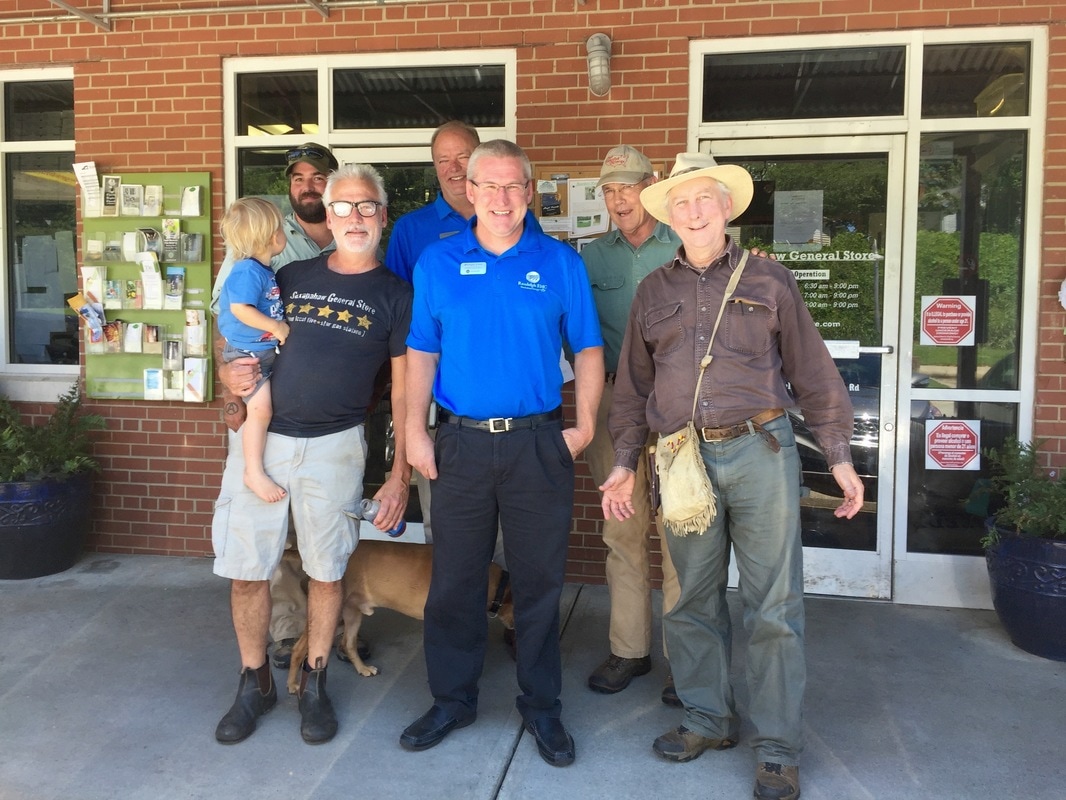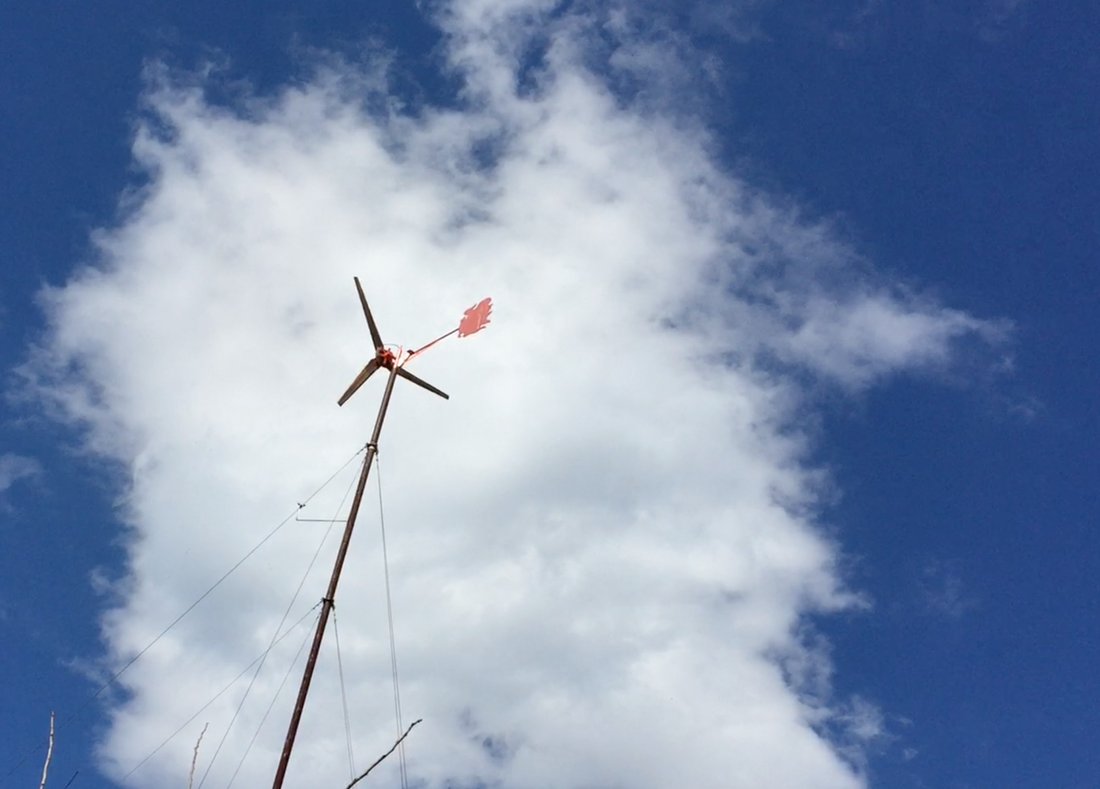|
Today, the stand-alone power system at the Handy Village Institute received a visit from a couple of very distinguished representatives of the Randolph Electric Membership Corporation. Fred Smith, Vice President of Economic Development and Compliance, and Michael Trent, Director of Innovative Energy Solutions, dropped by along with Doc Sydnor and Nick Harper for a late morning tour. Chris Carter began with a tour of his shop, where the March 2017 Homebrew Wind Turbine Workshop participants built another machine just like the one that will be going up at Doc's Braeburn Farm. Doc's turbine was built during the March 2016 Workshop at Handy Village Institute, and Nick Harper, Braeburn Farm Manager, participated in both workshops. Chris showed the visitors this year's turbine and explained in detail how it was fabricated and the advantages of the horizontal-axis, axial-flux, air-gap alternator design. Chris led the group from the shop down the path to see the two solar photovoltaic (PV) arrays, which are mounted on poles with trackers. One array serves the shop and the other serves the house, each of which also has its own battery set. The Homebrew wind turbine built by the Handy Village Institute team during Dan Bartmann's Midwest Renewable Energy Association workshop in June 2015 proudly spun up with the breezy gusts of a delightfully cool and dry mid-summer day. Days like this often follow atmospheric "cold fronts," one of which had passed through just the day before. When the wind picked up a little more at the height of the turbine on top of its 84-foot tilt-up tower, everyone could hear the quiet hum of power generation. The magnets connected to the hand-carved wooden blades spun past the stationary coils of the nacelle, and the three-phase power flowed through a heavy, buried cable directly to the next component of this stand-alone power system. The next stop was the shed that stores the batteries for the house and the control center for the integrated solar/wind system for the house. Chris had just added water to all 20 of these 1.5-Volt nickel-iron cells the day before, and he explained the features and requirements of these and other types of batteries, such as the 2-Volt lead-acid ones used to store power for the shop. On the other side of a wall, and accessed through a separate doorway, are the electronics that collect the power from both the photovoltaic (PV) solar panels and the wind turbine and store it in the batteries, and then serve selected loads in the house with either alternating-current (AC) or direct-current (DC) power. For example, the house has a water well- and booster-pump (for its cistern) and a refrigerator, radiant floor circulation pumps for heat, as well as a set of low-power safety lights that run on DC power, but other appliances and outlets use regular household AC power. These electronics also manage the charging of the battery and situations in which the batteries are full and cannot take in any additional power. In a grid-tied system, this surplus power could potentially be sold, but the stand-alone system must choose whether to cut back on generation, or "dump" the power. Chris explained how the solar PV and the wind generation complement one another well at this homestead scale in our Piedmont region of North Carolina. While we don't have the excellent, industrial-power generation-scale wind of the mountain or coastal regions, we do have frequent winds in the 7- to 20-mile per hour range that is ideal for the smaller turbines, especially in the winter when the days are shorter, the sunlight less intense, and there are many cloudy days. In the summer, there is more sunlight and less wind, but the calm is frequently punctuated by afternoon thunderstorms and continental weather systems moving through, as well as occasional tropical storms. We can manually shut down the turbine during hailstorms and hurricanes, and everything about the system is extremely well grounded to protect it from lightening strikes. Randolph Electric Membership Corporation is a rural electric cooperative that is very forward-looking and working hard to prepare their system for the future. They polled their membership about its interest in using more renewable power, and found overwhelming support. About 30% of the respondents said they would be willing to pay slightly higher rates for renewable power. The technologies and markets for power generation and storage are changing so rapidly that they have begun exploring new opportunities for balancing loads, energy storage, and power generation using a variety of new and distributed technologies to enhance their system and provide greater benefits to their membership. There are a handful of large solar farms in their territory, now, and they described buying a fuel cell to begin studying its features as a possible component of their system. They are experimenting with time-of-use prices for electric car charging to create incentives to spread out the consumer loads over time, and are very intrigued by the prospect of working with Doc, who is one of their members, to study his planned wind and solar PV hybrid system. Deborah Amaral joined the group for lunch at the Saxapahaw General Store, where the conversation about the prospects of expanding renewable energy at Randolph Electric Membership Corporation continued. She asked Michael Trent what he thought was the highlight of the tour of the stand-alone system, and he quickly smiled and shared that it was seeing the turbine's blades spinning and generating power in the breeze. Everyone agreed that relative to the wind turbines, solar cells are "boring," with no eye-catching moving parts to see. Having a turbine to watch makes a person more aware of the sky, the wind and the weather. Michael and Fred Smith mused about how great it would be to see small wind generators on Mount Shephard, a high-elevation landmark in their territory surrounding Asheboro, North Carolina. As the visit was wrapping up, Luther Livermon and Karen Bley, of Quarry Dog Adventures in Mebane, North Carolina, stopped by our table to chat. "Lu" was also in the workshop that fabricated the turbine which will be going up at Doc's farm. He currently has a large tracking solar array, and is interested in setting up wind power on his farm, too. He was very excited to learn of the Randolph cooperative's interest in distributed small wind and PV solar power generation. We were refreshed by the openness to change in the renewable energy market expressed by our guests, and look forward to our continued participation in the project at Braeburn Farm.  Jack Maxwell Barney, Nick Harper, Jeff Barney, Fred Smith, Michael Trent, Doc Sydnor, and Chris Carter celebrating local food and local power at the Saxapahaw General Store, after Randolph Electric Membership Corporation leaders visited the stand-alone hybrid wind and solar PV electricity generating systems at the Handy Village Institute site. Photo by Deborah Amaral.
0 Comments
Your comment will be posted after it is approved.
Leave a Reply. |
AuthorDeborah Amaral enjoys working with her hands to make things, and hopes to inspire others to do so, too. Archives
June 2022
Categories |
Workshops |
Company |


 RSS Feed
RSS Feed
